Plasma activated water prepared by different plasma sources: physicochemical properties and decontamination effect on lentils sprouts
Veronika MEDVECKá, Samuel OMASTA, Matej KLAS,Silvia MO?OVSKá, Stanislav KYZEK and Anna ZAHORANOVá
1 Department of Experimental Physics, Faculty of Mathematics, Physics and Informatics, Comenius University, Mlynská Dolina F1, 842 48 Bratislava, Slovakia
2 Department of Nutrition and Food Quality Assessment, Faculty of Chemical and Food Technology,Slovak University of Technology, Radlinského 9, 811 07 Bratislava, Slovakia
3 Department of Genetics,Faculty of Natural Sciences,Comenius University,Ilkovi?ova 6,Mlynská dolina,842 15 Bratislava, Slovakia
Abstract The pulsed corona discharge (CD) generated in contact with water and directly in water, and high-power air plasma jet (APJ) were studied for production of plasma activated water (PAW).The changes of physical (pH, redox potential, conductivity, temperature) and chemical(peroxides, nitrites, nitrates concentrations) properties of treated water were investigated.The comparison of CD generated in gas/water interface and underwater configuration in the same system showed that the interaction of reactive oxygen and nitrogen species formed in ambient air in gas/water system induces different chemical processes,leading to lower pH,higher oxidationreduction potential (ORP) and higher conductivity of PAW than in underwater discharge.High yield of peroxide was observed in both configurations.The PAW prepared by APJ exhibits high concentration of nitrites and nitrates according to supplied energy, and related significant decrease of pH and increase of ORP and conductivity after treatment.The antimicrobial effect of PAW prepared by CD and plasma jet on lentils sprouts was studied in different treatment and washing times.The APJ appears to have great efficacy on water activation resulted in strong decontamination effect.The PAW treated by APJ for 10 min led to bacterial reduction from initial 8.3 to 5.9 and 4.0 log10 CFU g?1 after 10 and 30 min of washing, respectively.
Keywords: plasma activated water, physicochemical properties, air plasma jet, underwater plasma, decontamination effect
1.Introduction
In the past decade,plasma activated water(PAW)has gained increasing attention for the application in medicine, water cleaning and decontamination of biological materials [1–4].Most of the studies are focused also on the application of PAW in agriculture for the enhancement of germination and growth of plants[5,6].Plasma activation of water used in the agriculture can lead to improvement of seeds and plants properties—inhibition of pathogens growth, germination ability and physiological parameters, with its reduced consumption or as an alternative to conventionally used chemicals for, e.g.seed dressing, pest and plant disease control or fertilizers, which is currently a very topical environmental issue [7, 8].The use of PAW in the food industry is a prospective option in processes, where the direct plasma application leads to negative effects on food products such as changes in colour, sensorial properties, or nutritional characteristics and it is a more environmental-friendly alternative to standard chemical methods [9, 10].
Non-thermal plasmas generated in ambient air,in oxygen or nitrogen containing working gases and noble gases produce a variety of reactive oxygen and nitrogen species(RONS), e.g.ozone, hydroxyl radicals, hydrogen peroxide,superoxide and nitrogen oxides.The interaction of plasma with liquid medium leads to the transport of RONS into liquid and the formation of secondary active species.In water, the main reactive species formed by plasma activation are OH radical, ozone, hydrogen peroxide, nitrites, nitrates, peroxynitrites, peroxynitrates and nitrous/nitric and peroxynitrous/peroxy-nitric acid[11].Reactive species are produced in liquid or liquid–gas interface and the formation has a different character if the plasma is generated directly in liquid or in gas with interaction with liquid [12].The characteristic properties of plasma-activated water, e.g.pH, electrical conductivity, oxidation-reduction potential (ORP) and concentration of RONS, are mainly influenced by the method of PAW generation—the type of plasma source and its electrical characteristics, the configuration of the experimental setup,liquid, working gas and processing time [13, 14].
Edible sprouts of beans, seeds and grains are a common part of a healthy diet, however fresh unprocessed sprouts(alfalfa,broccoli,mung beans)are one of the most sources of illness caused by microbial contamination due to their production in a warm and humid environment[15,16].The most common species contaminants are Salmonella, E.coli,Bacillus cereus, Listeria monocytogenes, Yersinia enterocolitica and Shigella species[17].As a standard method for decontamination, the chemical substances such as calcium hypochlorite, sodium hypochlorite, hydrogen peroxide, ethanol,and ozone,or physical processes(heat treatment,gamma radiation)are used to treat the sprouts[18–20].However,wet chemical treatment of sprouts is not considered as‘organic’or‘bio’due to the potential residues in sprouts and unfavourable impact on environment and several of chemical methods are not allowed in some countries in EU.Heat treatment applied in long-term process at lower temperature(50°C for hours or days) is limited to application during sprouting due to the inhibition effect on germination and short-term heating at higher temperature (90 °C) affects the nutrition characteristics.Modern method, such as irradiation can cause the nutrient losses (e.g.vitamin C) [21].In recent years, the application of low-temperature plasma in direct and indirect treatment by using cold atmospheric pressure plasma attracts wide attention of researchers [22–24].As it is a technology without the use of chemicals and without the need for working gases or vacuum equipment, it often replaces or complements many current technological procedures in a more environmentally friendly and economical way.Due to the need of water rinsing during the sprouting process, the PAW seems to be a more ecological alternative to chemicals(e.g.based on chlorine) and can be more gentle than direct plasma treatment[25].In term of safety of PAW applications,the deeper understanding of the post-treatment chemical processes and the temporal evolution of reactive chemistry in PAW need to be investigated before the safe application of PAW in practice.
In this work, we analyzed the chemical, physical and antibacterial properties of PAW prepared by high-voltage(HV) pulsed corona discharge (CD) generated above and in water and high-power plasma jet fed by air.The changes of pH, redox potential, conductivity, and temperature of the water were analysed immediately and up to 24 h after plasma treatment.The CD in two configurations was investigated to compare the properties and decontamination activity of PAW prepared in underwater discharge and discharge generated in ambient air in contact with water in the same system.The presented high-power air plasma jet (APJ), as a member of atmospheric pressure plasma jets (APPJ) producing reactive nitrogen and oxygen species (NO*,*OH, NO2?, NO3?, and H2O2, O2*?), was used for PAW production due to the high yield of active species causing antibacterial properties of water [26, 27].
2.Materials and methods
2.1.Plasma sources and PAW production
The preparation of PAW was realized by the two different plasma sources.First,HV pulses supplying CD was generated by discharging of HV capacitor (1.2 nF) using MOSFET switching device (HTS 501-20 –LC2, BEHLKE).The capacitor was charged by the HV source SLM 50 P 300(Spellman HV)with voltage up to 50 kV,current carrying capacity up to 6 mA and maximum power 300 W.The schematic picture of the experimental apparatus is shown in figure 1.
The samples of deionized water with volume of 100 ml were processed using two experimental configurations of apparatus, discharge was generated under the water (figures 1(a),2(a))and above the water(figures 1(b),2(b)).The HV electrode(stainless steel rod 1 mm in diameter)was placed 2–3 mm below the water surface and was insulated by 1 cm in diameter teflon cylinders to ensure that only one type of discharge occurs(figure 2(a)).The discharge developed in water(figure 1(a))was generated in a strong inhomogeneous electric field using positive voltage pulses of 22–23 kV with a duration of 400 μs, the breakdowns occurred in interval of tens of microseconds.The electrical power determined from electrical measurements was 12 W at 50 Hz of switching frequency.The stainless-steel ring placed at the bottom of beaker served as the grounded electrode.The atmospheric discharge above the water surface(figure 1(b))was generated by the same operational setup (HV source and switch)with similar stainless electrode with the insulation on its end to prevent the formation of discharge in water.Since the discharges in the air are ignited at lower voltages compared to water, the breakdowns occurred few hundreds of ns after switching HV in range of voltages from 16 to 18 kV on HV electrode leading to lower electrical power of 10 W.The current and voltage waveforms for both configurations were presented in figure 4.
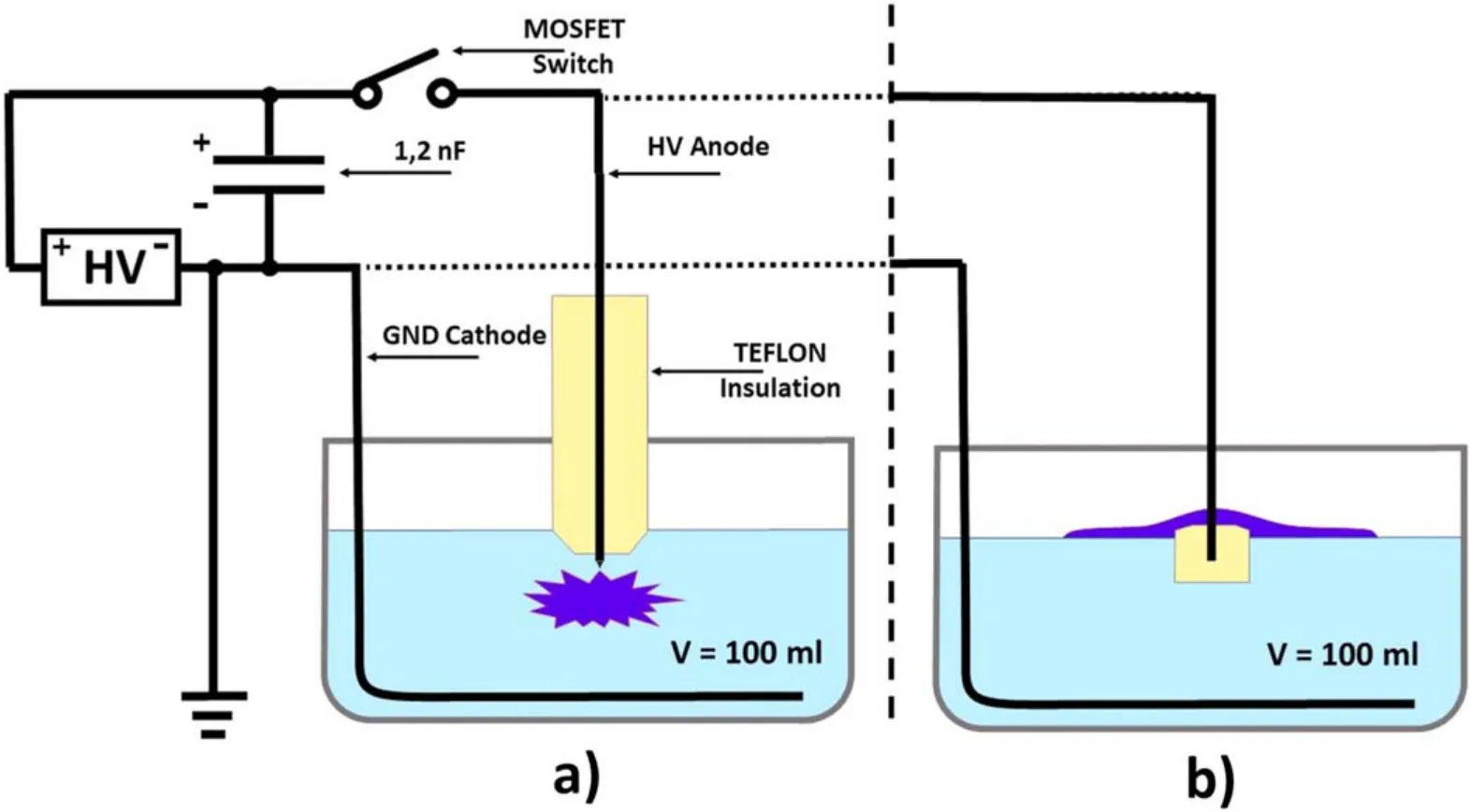
Figure 1.Scheme of HV pulsed corona discharge apparatus for preparation of PAW in two configurations.
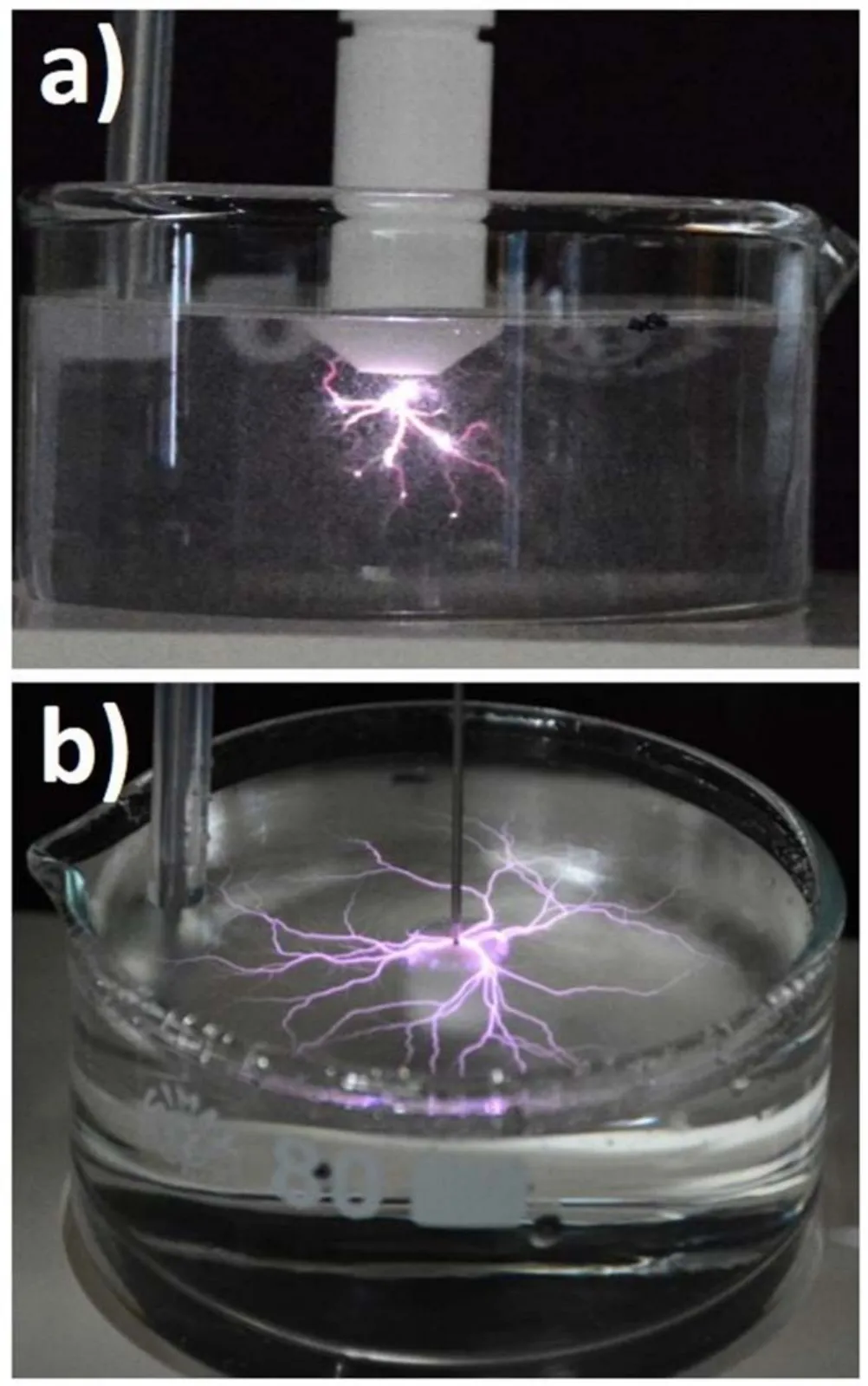
Figure 2.The HV pulsed corona discharge generated in water(a)and above the water level (b).
The second used plasma source—AAPJ is shown in figure 3.The plasma is generated between two electrodes separated by the copper neutrode.The copper cathode with hafnium insert is connected to the negative polarity of the HV DC power supply with current feedback.The discharge was maintained at the average power consumption of 400 W at a voltage of about 200 V and a current of 2.1 A.The typical voltage–current waveform is shown in figure 4.The plasma jet was fed by filtered ambient air with a flow rate of 5 slm.PAW was prepared in reagent bottle by immersing the plasma jet in deionized water to a depth of 1 cm as shown in figure 3.The volume of treated water was 200 ml and the treatment time was set to 10 min.The reagent bottle with water sample was placed in a container with cold water to keep the temperature of treated water below 30 °C.
2.2.Characterization of PAW
To understand the processes occurring during plasma treatment and mechanism of bacterial inactivation on lentils sprouts, the following physicochemical properties of PAW prepared by mentioned plasma sources were measured—pH,electric conductivity, ORP and peroxides (H2O2), nitrites(NO2?) and nitrates (NO3?) concentrations.
Hydrogen peroxide (H2O2) measurements were performed using titanium oxysulfate assay based on the reaction of H2O2with titanium oxysulfate (TiOSO4, Sigma-Aldrich)under acidic conditions.The result of this reaction is a yellow-colored product of perititanic acid (H2TiO4) with an absorption maximum at 407 nm [28].Due to possible H2O2decomposition by nitrites(NO2?)in acidic conditions,60 mM sodium azide (NaN3, Sigma-Aldrich) was added to the samples prior to mixing with titanium oxysulfate reagent.Sodium azide reduces nitrites to molecular nitrogen and preserves the H2O2concentration [29].
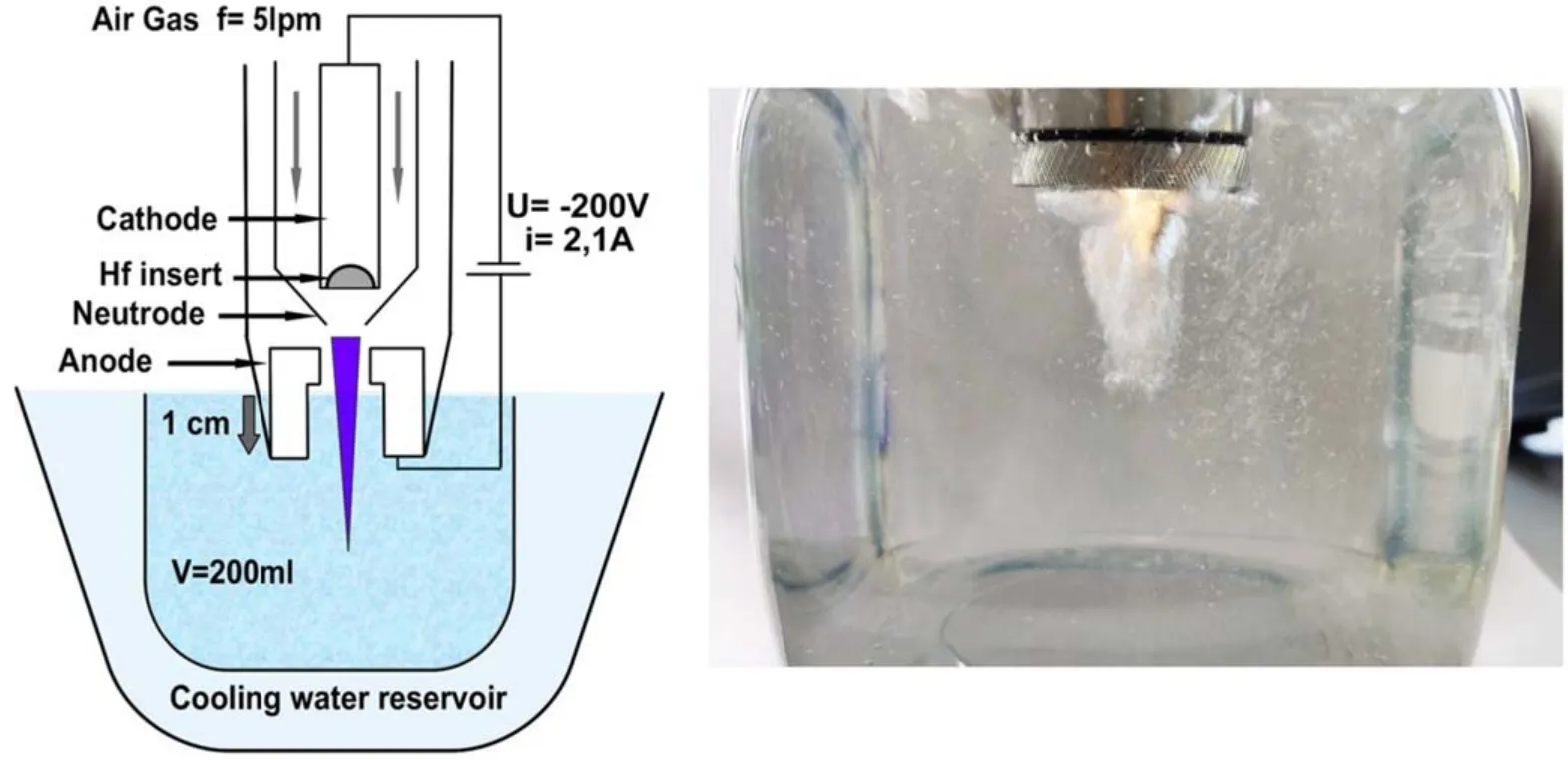
Figure 3.Scheme of experimental set-up for APJ treatment of water (left) and photo of APJ immersed in water in reagent bottle (right).
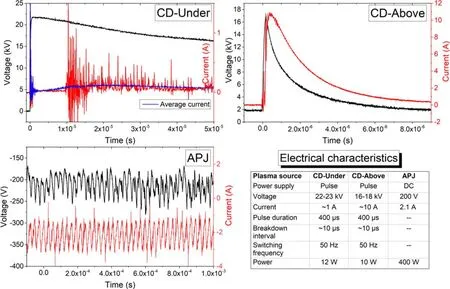
Figure 4.The current–voltage waveforms and electrical characteristics of corona discharge in different configurations and air plasma jet.
Concentrations of aqueous nitrites and nitrates(NO3?)were measured using Griess reagents (sulfanilamide and N-(1-Naphthyl)ethylenediamine).This colorimetric method is based on the reaction of NO2?with the Griess reagents under acidic conditions, which convert into a purple azo compound with an absorption maximum at 540 nm.Our experiments were performed following instructions of a colorimetric nitrite/nitrate assay kit (Sigma-Aldrich) that contained ready-to-use Griess reagents.Nitrates were converted into nitrites by the nitrate reductase enzyme and subsequently analyzed the same way as nitrites [11].
The pH, redox potential and temperature were determined using pH-ORP-temperature tester with replaceable electrode AD14 (Adwa Instruments).The handheld conductivity meter CON 150 (Thermo Scientific Eutech Instruments) was used for measurements of electric conductivity after plasma treatment.Measurements were realized in three samples of prepared PAW by each plasma source immediately after plasma treatment of water.The parameters of water prepared by HV pulsed CD were measured after 15 and 30 min, which is washing time in microbial experiments and the development of water properties was determined after 1,4 and 24 h.The PAW prepared by APJ was analyzed similarly in different times after activation including washing times of lentils sprouts—10,20 and 30 min and during storage after 1,2, 10 and 24 h.
2.3.Analysis of antimicrobial effect of PAW on lentils sprouts
The 30 g of sorted lentil seeds were placed into a glass jar,rinsed twice and then immersed in distilled water(600 ml)for 15 h at room temperature.After this time, the water was drained, and the seeds were rinsed twice with distilled water.The jar with seeds was placed in an inverted position and allowed to germinate.The sprouts were rinsed by distilled water twice a day and keep germinating for 48 h.The sprouts subsequently were harvested.Immediately after the sprout harvesting,the decontamination experiments were performed.
Before the inoculation, sprouts with similar characteristics (shape, color, and length, etc) were sterilized with 70%ethanol solution, stirring on a rotary shaker (150 rpm) for 5 min at room temperature.The residual ethanol was evaporated in an oven for 30 min at 30 °C.The sterile sprouts(5 g) were inoculated with 100 μl cell suspension of E.coli(cultivation for 16 h overnight, approximate cell density 108cells ml?1).The samples were shaken for 10 min and incubated for 2 h at room temperature to obtain a homogenous coating of the bacteria on the sprout surface.
For the PAW treatment prepared by HV pulsed CD (the treatment time of PAW was 10 and 20 min for discharge generated in water and 20 min for discharge generated above the water, respectively), the inoculated lentil sprouts (5 g)were immersed in 100 ml of prepared PAW in a sterile centrifuge tube under semi-aseptic conditions.The washing of the sample was ensured by a manual mixing of the test tube every 1 min, with total rinsing time of 15 and 30 min,respectively.As a positive control, the sprouts were rinsed with sterile distilled water for 30 min under the same conditions as for PAW.The unwashed sprouts served as a negative control.
The PAW treatment prepared by APJ was performed by dipping of lentil sprouts (5 g) in the 100 ml of PAW placing in glass jar (700 ml) under aseptic conditions for the decontamination of naturally occurring aerobic bacteria.The samples were rinsed on rotary shaker (120 rpm) at laboratory temperature for 10 and 30 min.As a positive control,a sample washed with sterile distilled water for 30 min was taken.The unwashed sprouts were used as a negative control.
The viable cell count after variety type of PAW treatment was determined using the standard plate count method.Sample sprouts(5 g)were taken into sterile Erlenmeyer flasks and 45 ml of 0.85% sterile saline solution, containing 0.1%Tween 80 as an emulsifier, was added aseptically.To release the bacteria attached onto the surface of the sample into the saline solution, the mixture was shaken at 150 rpm for 1 h at room temperature.The obtained washing solution was serially diluted and every dilution (200 μl) was placed on nutrient agar plates.Agar plates were incubated for 24 h at 37°C and then the colony forming units (CFU) were counted.The results were expressed as log10CFU g?1.All experiments were repeated at least triplicate.
3.Results and discussion
3.1.The concentration of hydrogen peroxide, nitrites and nitrates
One of the major active ROS in the application of PAW for decontamination is hydrogen peroxide and with nitrites and nitrates, they are the important long-lived RONS involved in the inactivation of microbial contamination.
In water treated by pulsed corona,a considerable amount of hydrogen peroxide was determined during the generation in water and above—(663.8 ± 65.7) μM and (527.2 ± 87.2) μM,respectively.The H2O2is formed mainly by reactions of OH radicals originating from the interaction of electrons with water molecules [30].As we can see in figure 5, pulsed corona generated in the air in gas/liquid interface produced less H2O2than the discharge generated directly in water, however, the small concentration of nitrates was detected(4.5 ± 2.2)mM,which is the corresponding value in PAW treated by low-power air discharges[31].The nitrogen oxides produced in the gas plasma are dissolved in water and lead to the formation of nitrites and nitrates [32].They can affect the production of peroxides since part of OH radicals and H2O2interact preferably in reactions with RNS.In [33], the PAW prepared using plasma generated in oxygen showed higher yield of H2O2than air plasma.Also,using noble gases such argon or helium as working gases can be effective to increase the concentration of H2O2in water [34].
The H2O2has a significantly higher ability of dissolution in water than NOxor O3generated in plasma according to Henry’s law coefficients[35],however,other factors,such as gas/water surface contact, gas flow rate and treatment time also play an important role[36].In plasma jet generated in air,significant levels of nitrites and nitrates in water—232.3 mM and 243.6 mM, respectively, were measured.The immersion of APJ in water produced bubbles with a high area of contact gas phase with water, leading to their effective dissolving in water [12].The interaction of nitrogen oxides with water leads to the formation of a variety of RNS in water.In APJ,the yield of nitrogen containing active species is significantly higher than that using jets fed by noble gases, e.g.argon, in which the formation of peroxides is more effective [37].
Nitrites and nitrates play an important role in the decontamination effect of PAW because they cause the formation of more variety of RONS—peroxynitrites/peroxynitrates, and peroxynitrous/peroxynitric acids.The peroxynitrites/peroxynitrates were reported as responsible for the synergic effect of H2O2,NO2?and NO3?presence and low pH in decontamination processes [38].The acids cause acidification of the water and decrease of pH creating an hostile environment for bacterial growth[11].
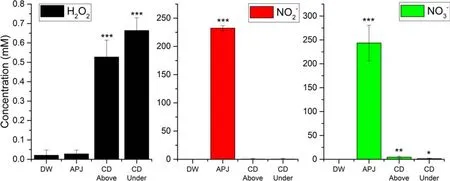
Figure 5.The concentration of hydrogen peroxide, nitrites and nitrates ions in plasma activated water by air plasma jet (APJ) and pulsed corona discharge generated above (CD-above) for 20 min and underwater (CD-under) for 10 min.
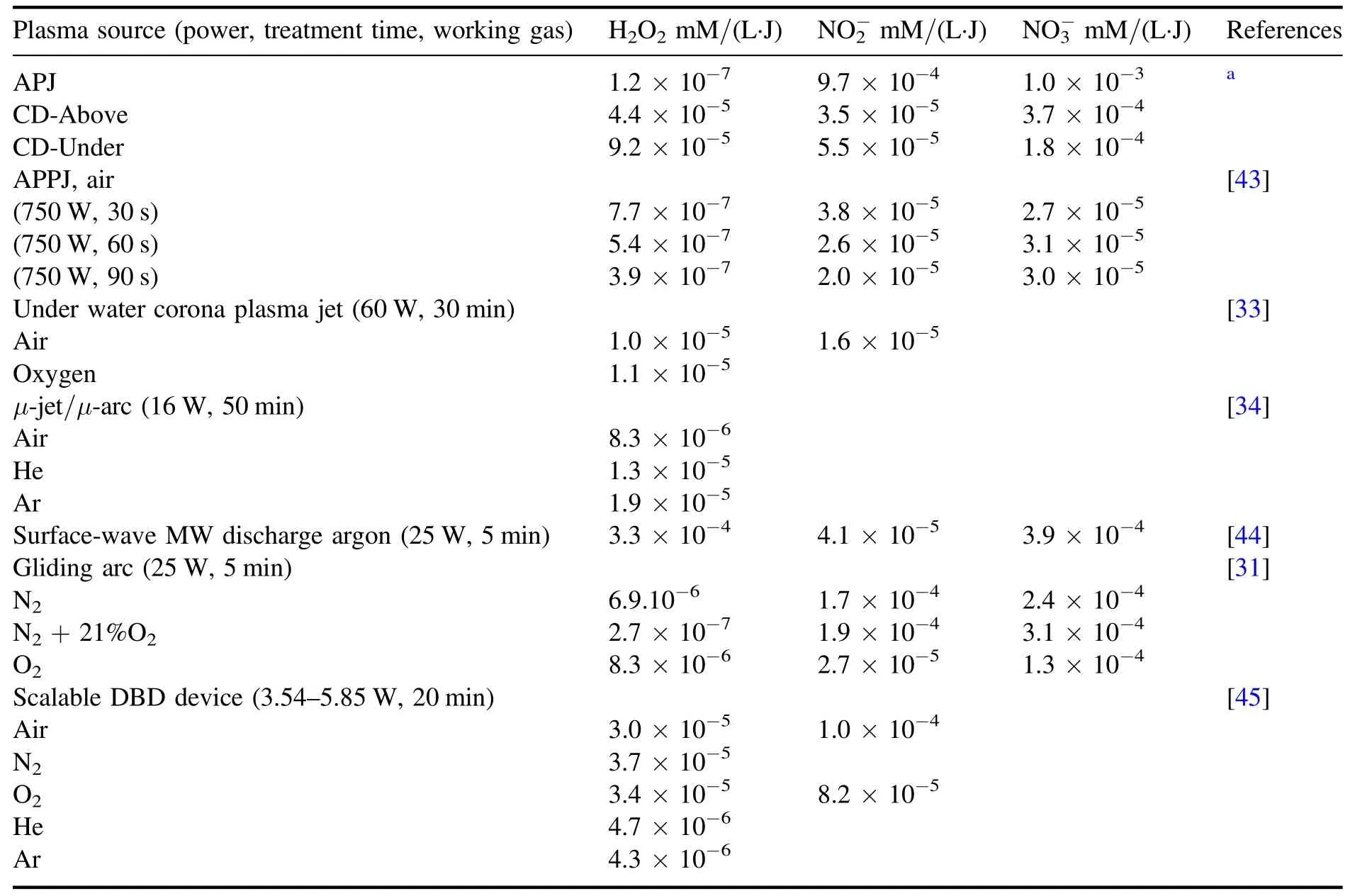
Table 1.The overview of different plasma sources used for PAW preparation and estimated H2O2,NO2?and NO3?concentration according to supplied power and treatment time.
To compare the energy efficiency of H2O2, NO2?, and NO3?formation by applied plasma sources,the concentrations of species according to input power and treatment time are presented in table 1.The CDs in water/air contact can produce H2O2or O3as the main chemically active molecule due to the relatively high flux of electrons[39],and the formation of hydrogen peroxide in water is according to energy consumption relatively more efficient[40,41],than using plasma jets or gliding arc [31].The application of plasma jets fed by air or N2-containing working gases on liquid media leads to formation of nitrites and nitrates at the expense of peroxide[34,42].By optimization of treatment conditions,we reached in our experiments meaning concentration of H2O2in underwater pulsed corona—PAW and significantly high concentration of NO2?and NO3?using APJ with respect to input power and treatment time—9.22 × 10?5, 9.68 × 10?4and 1.01 × 10?3mM/(L·J), respectively.For brief comparing, table 1 shows the values of H2O2, NO2?and NO3?concentration with respect to supplied power and treatment time for different plasma sources in current studies with available parameters for estimation.
3.2.HV pulsed corona PAW—the measurement of pH, ORP,conductivity and temperature
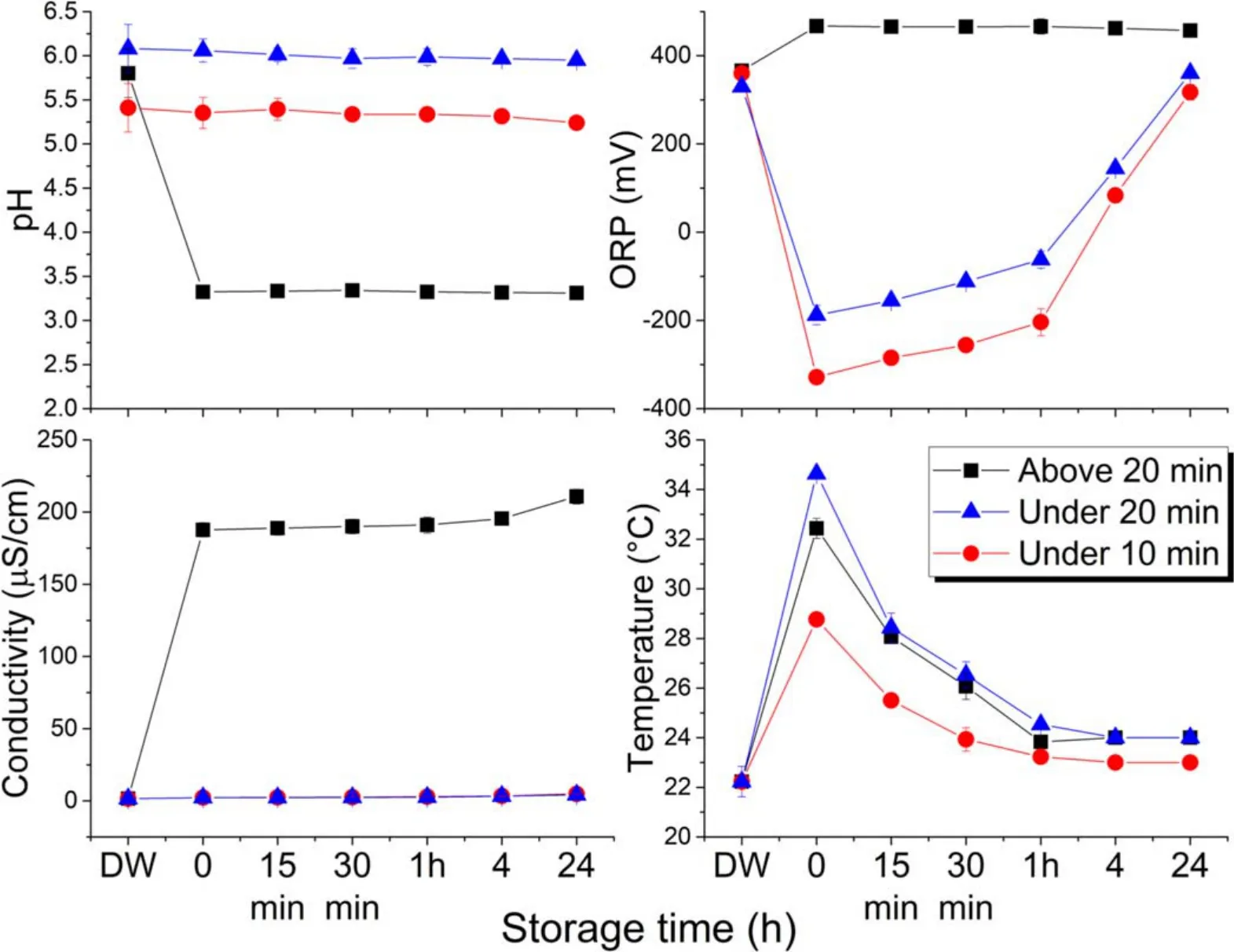
Figure 6.The time development of pH, redox potential, conductivity, and temperature in PAW prepared by pulsed corona discharge above and under water treatment.
The pH measurements of water activated by HV pulsed CD generated in air/water interface showed a reduction of pH from 5.8 to 3.3(figure 6)due to the acidification through the formation of hydrogen peroxides, nitric acid and peroxynitrous acid as secondary products of the interaction between NOxand water[46].The value of pH was stable even after 24 h from plasma activation.The change of pH in water activated by pulsed corona directly in water was negligible and corresponded with pH measurements observed in PAW treated in nitrogen-free conditions [33].The difference of pH development is strongly related to by the absence of nitrogen in underwater discharge.The acidic behaviour of non-thermal air plasma is initiated by production of nitrogen ions [47].Besides the dilution of NO2/NO3in water, the acidic properties are caused by the secondary compounds generated in water during interaction of RONS formed in ambient air with water including HNO2,HNO3, peroxynitrites/peroxynitrates and peroxynitric/peroxynitrous acid.
ORP is a factor,which can be related to the antimicrobial activity of PAW.Pulsed CD generated above the water increased the ORP from 366 to 467 mV (figure 6).A similar effect was observed in most experiments with PAW obtained by plasma generated in the air or other gases [43].The increase in ORP is related to the formation of ROS in water[48].The ORP value stayed stable even 24 h after plasma activation.The time developments of pH, ORP and conductivity in PAW treated for 10 min have the same character(results are not presented).
However, the situation is different for PAW prepared by the pulsed CD generated directly in water.After treatment for 10 min and 20 min, the ORP decreased from +366 mV to?329 mV and ?188 mV, respectively.Most of the studies dealing with plasma/liquid interaction are focused on plasma sources generating plasma in gas and then interacting with water.The presence of nitrogen can affect the character of reactions in gas/plasma interface.On the other hand, the pulsed corona generated directly in water causes formation of radicals H·, OH·, O·, and other reactive species (H2O2, H2,H2O+), which initiate secondary reactions detailed described in [49].Many of the products have reducing properties,mainly hydrogen, superoxide O2?· radical and molecular hydrogen and they participate in reduction reactions[50].The OH· radicals readily forms long-lived hydrogen peroxide[51], which can act as oxidant and reductant [30].The return of the ORP value to the initial level observed after 24 h(figure 6) might be related to post-treatment reactions, e.g.decline in concentration of hydrogen peroxide with storage time, which was observed in [8].
The conductivity of PAW reflects the concentration of ions in water.Compared to deionized water (1.5 μS cm?1),the increase to 187.8 μS cm?1was measured in PAW treated by pulsed CD generated above the water (figure 6).After the activation by underwater CD, the conductivity of PAW did not change.The value of conductivity differs due to the formation of ions originated from reactions in the gas phase/water interface.The obtained results correspond with measurements of nitrites/nitrates concentrations and pH(figures 5 and 6).A few studies reported that most of the characteristics tend to be stable after long-term storage of PAW, however,the conductivity showed changes in first 3 d after activation[34].In our experiments, we observed a slight increase of conductivity after 24 h (figure 6).The value in water treated by plasma above and under the water reached 210.8 μS cm?1and 4.2 μS cm?1, respectively.This can be caused by the development of chemistry in PAW, e.g.decrease of H2O2,and increase in nitrites and nitrates [8].

Figure 7.The time development of pH,redox potential,conductivity and temperature of PAW prepared by air plasma jet for 10 min.
The temperature of the PAW after 20 min of plasma treatment with a CD under and above the water was 34.6 °C and 32.4°C,respectively.As expected,the plasma generated under the water has a slightly higher effect due to the direct energy transfer between plasma and water, compared to the air plasma/water system.
3.3.APJ PAW—measurements of pH, ORP, conductivity and temperature
APPJs are effective in the production of PAW with sufficiently low pH and high ORP [52].High power APJ described in this paper was designed to produce high amount of nitrogen oxides which,as mentioned above,are very effective in acidification of PAW for decontamination.The flow rate of air was optimized and the optimal contact of gas plasma with water was ensured by immersion of plasma jet into the water to obtain high nitrates/nitrites yield for application in decontamination.The measurement of pH shows a decline from an initial value of 5.9–2.6 immediately after plasma treatment (figure 7).The pH value was stable for 24 h.Low pH is related to the high level of nitrites and nitrates measured in water after plasma treatment.Similarly, redox potential increased from 366 to 585 mV.During storage of PAW, the value of ORP varied in the range of 580–590 mV.
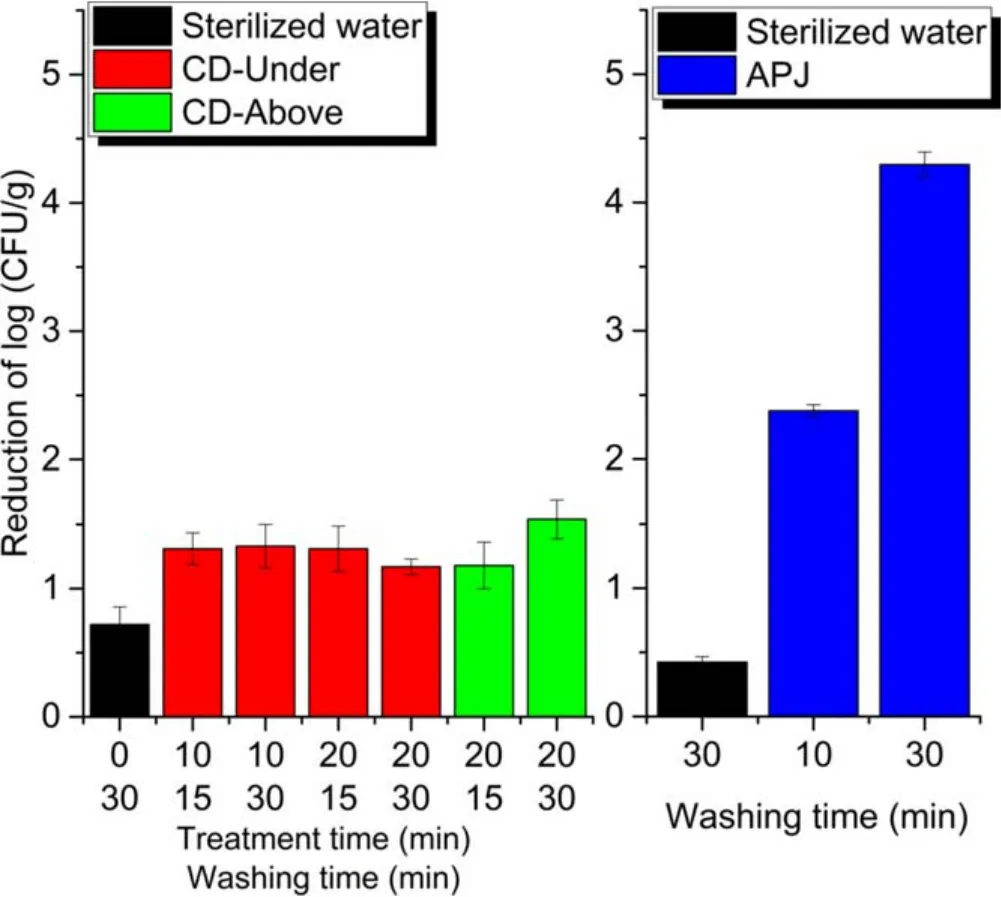
Figure 8.Reduction of E.coli and aerobic bacteria on lentil sprouts after washing with PAW prepared at different conditions by HV corona discharge generated in water and above (left)and air plasma jet (right).
The conductivity increased from 2.8 to 1023 μS cm?1immediately after plasma treatment of water.Nitrogen component of the feeding gases used in the plasma treatment of water has a crucial impact on conductivity via the formation of ions.In working gases such Ar,O2and their mixture,the conductivity is facilitated by H3O+ions and is significantly lower in nitrogenfree gases treated PAW [6].The value of conductivity during storage of PAW continued to rise to 1047, 1171, 1436 and 1791 μS cm?1after 1,2,10 and 24 h,respectively.In the longterm storage, minor changes in parameters of PAW were observed, but within 24 h after treatment, the physical and chemical properties of PAW can be affected by post-reactions occurring in water [53, 54].The temperature increased from room temperature (23 °C) to 47.5 °C after 10 min of plasma treatment due to high power supplied to water via plasma jet.To eliminate the decontamination effect of high temperature, activated water was cooled before the microbial experiments.
3.4.Microbial analysis of lentil sprouts after washing by HV pulsed CD and APJ
The results of the decontamination effect of PAW, prepared by HV pulsed CD generated in and above the water, are shown in figure 8.After PAW treatment, the microbial preliminary study exhibited moderate changes in E.coli population of the lentil sprouts (p < 0.05) as compared to the negative and positive control, respectively.As indicated in figure 8, no significant differences in microbial effect depending on the treatment and washing time were observed using PAW prepared by underwater discharge.The reduction varied from initial 7.5 to 6.2–6.3 log10CFU g?1.The noticeable reduction was detected using PAW prepared by discharge generated above the water.The decline of E.coli population on lentil sprouts after 30 min of washing was up to 1.5 log10CFU g?1.
By application of PAW prepared by APJ, the decrease more than 2 log10CFU g?1from the initial count of aerobic bacteria (8.3 ± 0.1 log10CFU g?1) was observed on sprouts washed for 10 min.The longer washing time led to the higher decontamination level.The washing for 30 min resulted in decontamination of about 4.3 log10CFU g?1.
In the work of [55], the reduction of two strains of E.coli(O157 and O104)was studied by the combination of PAW and ultrasound on alfalfa and mung beans sprouts.In this case, the reduction by PAW at washing of samples for 1,3 and 16 h was up to 2 log10CFU g?1.In most studies, PAW is used for the removal of microbial contamination directly in water or aqueous medium [56].Plasma is directly applied to liquid medium with E.coli or for example suspension of E.coli is added to PAW[57–59].In our experiments, we used PAW in decontamination of E.coli on the substrate—inoculated on lentils sprouts.The action time of PAW on the E.coli on sprouts is limited to washing time during processing but reached reduction level is perspective in the application in practice.In addition, the preparation of edible sprouts is a procedure,where the application of water is essential and PAW utilization can eliminate the need for chemical decontamination.
4.Conclusions
In this study,the properties of PAW prepared by HV pulsed CD in two configurations and high-power APJ were investigated.Using the pulsed CD,a comparison of PAW properties generated in gas plasma/water interface and underwater discharge in the same system showed the important role of the presence of nitrogen in plasma/liquid system leading to the formation of RNS in PAW.Compared to underwater discharge, PAW produced by discharge above the water showed major changes in properties—drop of pH (3.3), an increase of ORP, a significant increase of conductivity, and formation of RNS in water.
Using APJ, after 10 min of water treatment, the pH dropped to 2.6, ORP rose from 366 to 585 mV, and conductivity increased to 1023 μS cm?1from the initial 2.8 μS cm?1.The intense yield of nitrites and nitrates in water were obtained,compared to other plasma sources.As a result,the strong decontamination effect of PAW prepared by APJ was observed.The reduction of aerobic bacteria on lentils sprouts caused by PAW prepared by air APJ treatment for 10 min was 2.4 and 4.3 log10CFU g?1from initial 8.3 log10CFU g?1after 10 and 30 min of washing, respectively.
In food and agriculture processes, such as edible sprouts preparation, where the use of water is essential,the replacement of the regular water by PAW might be promising approach for elimination of chemicals in standard methods of sprouts decontamination and also for regulation of water consumption.
Acknowledgments
This study was supported by the Slovak Research and Development Agency under the contract Nos.APVV-16-0216,APVV-19-0386 and Slovak Grant Agency No.1/0782/19.
ORCID iDs
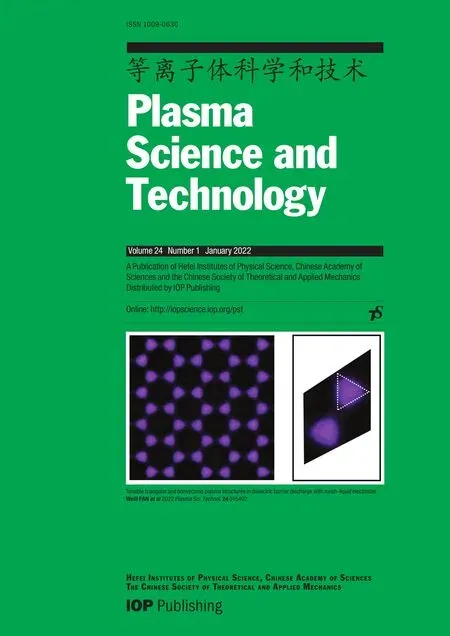 Plasma Science and Technology2022年1期
Plasma Science and Technology2022年1期
- Plasma Science and Technology的其它文章
- Design of improved compact decoupler based on adjustable capacitor for EASTICRF antenna
- W fuzz layers: very high resistance to sputtering under fusion-relevant He+irradiations
- Discharge and post-explosion behaviors of electrical explosion of conductors from a single wire to planar wire array
- Influence of anode temperature on ignition performance of the IRIT4-2D iodine-fueled radio frequency ion thruster
- Experimental study on plasma actuation characteristics of nanosecond pulsed dielectric barrier discharge
- A novel double dielectric barrier discharge reactor with high field emission and secondary electron emission for toluene abatement
